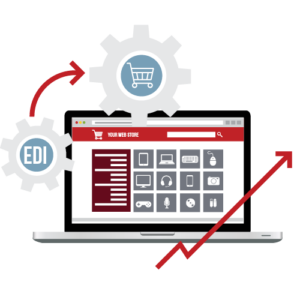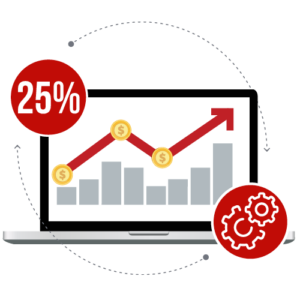

We get a lot of questions concerning Electronic Data Interchange (EDI) and e-commerce. The most common question might be: “If I’ve already set up EDI with most of my clients, why should I consider adding a web store?”
We understand that you have questions. We’re happy to answer them! Jump in to learn why EDI and e-commerce are the perfect match!
What is EDI?
Electronic Data Interchange (EDI) has proven to be of major value to businesses. By automatically placing orders, EDI decreases processing costs and order handling time considerably. Moreover, automation improves accuracy by reducing data entry errors.
However, even if most of your orders are processed via EDI, orders from clients without EDI still require a considerable amount of time from your resources. In our experience, companies process over 75% of their orders with EDI. So, in most cases, just 25% of all orders are handled with e-commerce. While that might not seem significant, it means that clients placing the other 25% of orders are limited to old, traditional methods such as phone, fax or email, and accessing information through sales representatives.
For your sales staff, this means a lot of extra work. A second consideration is that an EDI system is not a tool used to promote new product information or offer a full catalog of items for sale to your clients. Nor does it provide supporting product information or any type of online user experience.
EDI is primarily used for large, recurring orders and does not allow your customers to find new products or add complementary goods to their orders. It does not tempt customers to add more items to their order through cross-selling or upselling either.
Where does B2B e-commerce come into play?
The main benefit of having a web store is that all your customers – even the ones with EDI – will have a significantly better buying experience because they can seamlessly order the goods they need.
Imagine looking for a very specific product. In contrast to EDI, you want to see all available product specifications. Unfortunately, finding the right product and eventually ordering it – whether by phone or email – can be tedious and time-consuming. This is where e-commerce comes into play. Although, like EDI, sales orders suitable for e-commerce are processed online, they usually have a more occasional character, like the example above. With e-commerce, it’s possible for customers to order at their convenience, instead of in predetermined large batches as is the case with EDI.
B2B e-commerce lets you display different types of supporting product content, like spec sheets, images or videos. It provides a website where your entire product catalog, including spare parts, can be showcased in an attractive and interactive manner. This allows your customers to navigate effortlessly through your products and helps them make a well-informed buying decision.
B2B e-commerce is more than a sales portal or computer language like EDI. A web store grants B2B companies the opportunity to improve their online presence. You can also introduce clients to your organization and your products through your web store, as well as via email and videos.
In other words, a web store can tempt customers to engage in cross-selling and upselling, increasing conversions. Additionally, online orders are processed in real time with the relevant data stored electronically, speeding up order turnaround and creating substantial value for your customers and your business.
Booming B2B e-commerce growth
Although the B2C market has received most of the attention, the real opportunity for e-commerce is in the B2B market.
Previously, Frost & Sullivan predicted that in 2020 the B2B e-commerce market will be twice the size of the B2C e-commerce market. It is therefore no surprise that approximately 55% of the companies we interviewed stated they have a web store for their B2B clients.
These companies also noted they are searching for a more extensive e-commerce system to maximize their online potential and capture a larger piece of the market.
How can this exponential growth in B2B e-commerce be explained?
A B2B e-commerce platform assists companies in three key areas:
Smarter sales
The first constitutes higher sales efficiency, realized through a fast, 24/7 ordering system where customers can navigate effortlessly through the entire product catalog with direct access to their order history.
Happier clients
Secondly, e-commerce improves your customer service. With access to a portal for order tracking and supporting product information, your clients have everything they need for self-service.
Reduced costs
Lastly, B2B e-commerce is great for your bottom line. Your staff does not have to waste valuable time on manual order processing. Moreover, efficiently displaying your entire catalog offers plenty of cross-selling and upselling opportunities. Given these benefits, many B2B companies are considering adding an online sales channel.
Having said that, starting a B2B e-commerce site works particularly well when it is used as an addition to an existing EDI system.
The different roles of EDI and B2B e-commerce
There are two important things to establish here.
First of all, it’s important to understand that both EDI and B2B e-commerce have their own distinctive features. If you are able to recognize and acknowledge these, they can complement each other, increasing your online success.
Secondly, even if the majority of your clients have set up Electronic Data Interchange, the orders from clients who haven’t will still require a significant amount of your resources. How much time do you think your sales support staff is still spending on processing orders manually? Combining EDI and e-commerce will streamline sales for all your customers.
EDI and e-commerce in action
Recently, I visited an automotive factory. As I watched the assembly line, I realized the automotive industry might be one of the clearest examples of an industry where automated order processing is indispensable. Today’s well-oiled car production lines rely on the seamless delivery of parts – and that means the seamless exchange of information between car manufacturers and their suppliers. For this, EDI is often used.
EDI has proven to be of major value to businesses, processing orders digitally and automatically enhances speed, accuracy and business efficiency. It caters for a specific kind of client, namely one that is large enough to have the resources to implement the system.
In addition, Electronic Data Interchange systems are built for placing large, recurring orders. Since the products ordered are known, no product information – such as description, images or pricing – is provided, or needed.
However, imagine you’re looking for a very specific replacement part. In contrast to EDI, you’ll want to see all the product specifications available. Unfortunately, finding the right product and eventually ordering it – whether by telephone or email – can be tedious and time-consuming.
This is where e-commerce comes into play.
E-commerce and EDI orders are both processed online. However, orders more suited to web stores are more occasional in character, as illustrated in the example above.

How B2B e-commerce complements EDI (and vice
versa)
The main benefit of having a web store is that all your clients – even the ones using Electronic Data Interchange – will have a significantly better buying experience because they can seamlessly order the goods they need. It operates as a complete self-service portal, providing information such as order history and invoices.
Moreover, it is possible to find new, unknown products. EDI does not incentivize customers to purchase more or different products. In contrast, a web store has the capability to help you cross-sell and upsell products, while providing product information, product assortment information and contextual information.
EDI and e-commerce in numbers
We’ve spoken to a lot of businesses that have set up EDI. Usually, they process over 75% of their orders that way. So in most cases, only up to 25% of all orders can be handled with e-commerce.
Although that doesn’t seem significant at first, it means that 25% of your clients are limited to placing orders via traditional methods such as the telephone and accessing information through sales agents. For your sales staff, this means a lot of extra work. Processing this 25% of orders with e-commerce could lead to huge cost savings and boost your overall customer satisfaction.
The marriage point
At the Volvo manufacturing plant, I learned about the concept of the ‘marriage point.’ It is considered one of the highlights of the entire production process for every car manufacturer. At this point, the drivetrain – consisting of the engine, transmission, axles and exhaust system – meets the corresponding body. At just the right moment, the two are bolted together.
We should look at EDI and B2B e-commerce in the same way. E-commerce comes in where Electronic Data Interchange is no longer sufficient, and vice versa. Regardless of whether they form the majority, clients without EDI are probably tying up all your sales resources. With a web store, they are not only taken care of, you can actually benefit from a group of customers that would normally have been left out.
In short, combining EDI and e-commerce will streamline sales for all your customers, while providing a significantly better buying experience for everyone.
Frequently asked questions
I already have EDI. Why do I need e-commerce?
In short: While EDI and web stores do overlap to a certain degree, web stores offer your business opportunities that simply aren’t feasible with EDI.
EDI (electronic data interchange) is a great way to automate bulk orders from your customers. This saves time and energy for both you and your clients while ensuring that there is always have enough key inventory in stock.
However, EDI isn’t suited to all types of purchases. In our experience, companies use EDI to process 75% of their orders. That means that a quarter of your total orders still require your customers to reach for the phone, or send an email (or even a fax). It’s less convenient for everyone involved, and much less efficient and profitable for you.
Then there’s the matter of marketing. Unlike EDI, a web store makes it easy for (prospective) customers to browse your entire product catalog. This offers more cross-selling and upselling opportunities, and increases the chance that they will find relevant products that they maybe didn’t even realize you stock.
What is e-commerce?
E-commerce (or ecommerce, eCommerce, or one of countless other possible variations) simply put, is the concept of buying and selling online. Everything from buying from a local artist via their Etsy store to winning a bid on eBay and even automating huge business orders via EDI: it’s all e-commerce. While the e-commerce landscape is diverse (think online marketplaces like Facebook, Ebay, Amazon, etc.), the online commerce channel you’ll be most familiar with is the web store.
Why is digital transformation in e-commerce necessary?
If it’s not broken, don’t fix it – right? Most business leaders today don’t think so. Across all sectors, organizations have felt the impact of a pandemic, followed by political and socio-economic instabilities. An investment in digital transformation is also an investment into future-proofing your business. The more agile your strategy, the better your chances for sustaining growth through all kinds of disruption.

Dive deeper into e-commerce for the manufacturing industry
EDI and web stores aren’t the only technology driving the manufacturing industry’s digital transformation.



